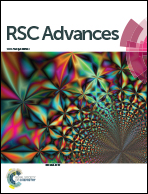A bright yellow light from a Yb3+,Er3+-co-doped Y2SiO5 upconversion luminescence material†
Abstract
A bright yellow light from Yb3+ and Er3+ doped Y2SiO5 upconversion materials in particle and fiber form were prepared by a co-precipitation, and electrospinning method. The morphologies of the prepared samples were investigated through FT-IR, FE-SEM, XRD and Raman measurements. The upconversion properties of the samples are carefully studied based on the absorption, fluorescent and decay time measurements. Under 980 nm excitation, the prepared material shows bright yellow emission. By controlling the concentration of Yb3+ or Er3+ and the excitation laser power, the ratio of red to green emission intensity can be varied to adjust the color tuning properties of the phosphor. The upconversion mechanism, and transition probabilities were elucidated owing to Judd–Ofelt theory. The radiative quantum efficiencies for the red (4F9/2) and green (4S3/2) bands were estimated to be 87% and 55%, respectively. The color coordinates of the system were evaluated as a function of the dopant concentrations and plotted on a standard CIE index diagram. The change of band intensity ratio with dopant concentrations gives a promising potential of the current phosphor for lighting application.


 Please wait while we load your content...
Please wait while we load your content...